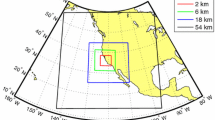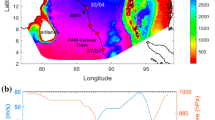Abstract
Several wind fields developed for Hurricane Katrina (2005) in the US Gulf of Mexico (GOM) are applied with the ADCIRC hydrodynamic model to explore the sensitivity of predictions of coastal surges to wind fields developed by alternative methods. The alternative model predictions are evaluated against water level measurements provided by gages at two coastal locations. It is found that all the post-event analyzed wind fields yield a range of predictions of only ±10% of the available peak surge measurements regardless of whether the wind fields are produced by dynamical boundary layer models, kinematic analysis methods or a blend. However, the richness of meteorological forcing data in the GOM is not typically matched in other basins affected by tropical cyclones and errors may be much larger where storm intensity and size parameters are estimated mainly from satellite data. The attributes and remaining critical deficiencies of current methods for surface wind specification in both data-rich and data-poor environments are reviewed.






Similar content being viewed by others
References
Atkinson J, Wamsely T (2007) Representation of vegetation on the wind boundary layer and surface bottom friction. 10th international workshop on wave hindcasting and forecasting and coastal hazard symposium, North Shore, Hawaii, 11–16 November 2007
Cardone VJ, Resio DT (1998) Assessment of wave modeling technology. Fifth international workshop on wave hindcasting and forecasting, Melbourne, FL, 26–30 January 1998
Cardone VJ, Pierson WJ, Ward EG (1976) Hindcasting the directional spectrum of hurricane generated waves. J Petrol Technol 28:385–394
Cardone VJ, Graber HC, Jensen RE, Hasselmann S, Caruso MJ (1994) In search of the true surface wind field in SWADE IOP-1: ocean wave modelling perspective. Global Atmos Ocean Syst 3:107–150
Cardone VJ, Jensen RE, Resio DT, Swail VR, Cox AT (1996) Evaluation of contemporary ocean wave models in rare extreme events: Halloween storm of October, 1991; Storm of the century of March, 1993. J Atmos Ocean Technol 13:198–230. doi:10.1175/1520-0426(1996)013<0198:EOCOWM>2.0.CO;2
Cardone VJ, Cox AT, Lisaeter KA, Szasbo D (2004) Hindcast winds, waves and currents in Northern Gulf of Mexico in Hurricane Lili (2002). Offshore technology conference, Houston, TX, 3–6 May 2004, Paper OTC 16821
Cardone VJ, Cox AT, Forristall GZ (2007) Hindcast of winds, waves and currents in Hurricanes Katrina (2005) and Rita (2005). Offshore technology conference, Houston, TX, 30 April–3 May 2007, Paper OTC 18652
Chen SS, Price JF, Zhao W, Donelan MA, Walsh EJ (2007) The CBLAST-Hurricane Program and the next generation fully coupled atmosphere–wave–ocean models for hurricane research and prediction. Bull Am Meteorol Soc 88(March):311–317. doi:10.1175/BAMS-88-3-311
Chow SH (1970) A study of the wind field in the planetary boundary layer of a moving tropical cyclone. MS Thesis, School of Engineering and Science, New York University, New York, NY
Cooper C, Stear J (2006) An historical perspective of hurricane intensity in the Gulf of Mexico during 2004–2005. Offshore technology conference, Houston, TX
Corbosiero KL, Wang W, Chen Y, Dudhia J, Davis C (2007) Advanced research WRF high frequency model simulations of the inner core structure of Hurricanes Katrina and Rita (2005). 8th WRF user’s workshop, National Center for Atmospheric Research, Boulder, CO, 11–15 June 2007
Cox AT, Cardone VJ (2000) Operational system for the prediction of tropical cyclone generated winds and waves. 6th international workshop of wave hindcasting and forecasting, Monterey, California, 6–10 November 2000
Cox AT, Cardone VJ (2007) Workstation assisted specification of tropical cyclone parameters from archived or real time meteorological measurements. 10th international workshop on wave hindcasting and forecasting and coastal hazard symposium, North Shore, Hawaii, 11–16 November 2007
Cox AT, Greenwood JA, Cardone VJ, Swail VR (1995) An interactive objective kinematic analysis system. Proc. 4th international workshop on wave hindcasting and forecasting, Banff, Alberta, 16–20 October 1995, pp 109–118
Cox AT, Cardone VJ, Counillon F, Szasbo D (2005) Hindcast of winds, waves and currents in Northern Gulf of Mexico in Hurricane Ivan (2004). Offshore technology conference, Houston, TX, 2–5 May 2005, Paper OTC 17736
Donelan MA, Haus BK, Reul N, Plant WJ, Stiassnie M, Graber HC, Brown OB, Saltzmann ES (2004) On the limiting aerodynamic roughness of the ocean in very strong winds. Geophys Res Lett 31:L18306. doi:10.1029/2004GL019460
Dvorak VF (1984) Tropical cyclone intensity analysis using satellite data. NOAA Tech Rep NESDIS 11:47
Emanuel K, Raveal S, Vivant E, Risi C (2006) A statistical deterministic approach to hurricane risk assessment. Bull Am Meteorol Soc 87(March):299–314
Forristall GZ, Ward EG, Cardone VJ, Borgman LE (1978) The directional spectra and kinematics of surface waves in Tropical Storm Delia. J Phys Oceanogr 8:888–909. doi:10.1175/1520-0485(1978)008<0888:TDSAKO>2.0.CO;2
Franklin JL, Black ML, Valde K (2003) GPS dropwindsonde wind profiles in hurricanes and their operational considerations. Weather Forecast 18:32–44. doi:10.1175/1520-0434(2003)018<0032:GDWPIH>2.0.CO;2
Graber HC, Cardone VJ, Jensen RE, Slinn DN, Jagen SC, Cox AT, Powell JMD, Grassl C (2006) Coastal forecasts and storm surge predictions for tropical cyclones: a timely partnership. Oceanography 19(1, March):130–141
Holland GJ (1980) An analytic model of the wind and pressure profiles in hurricanes. Mon Weather Rev 108:1212–1218. doi:10.1175/1520-0493(1980)108<1212:AAMOTW>2.0.CO;2
IPET (2007) Performance evaluation of the New Orleans and Southeast Louisiana hurricane protection system. US corps of engineers. http://ipet.wes.army.mil
Jensen RE, Cardone VJ, Cox AT (2006) Performance of third generation wave models in extreme hurricanes. 9th international wind and wave workshop, Victoria, BC, 25–29 September 2006
Knabb RD, Rhone JR, Brown DP (2005) Tropical Cyclone report hurricane Katrina, 23–30 August 2005, updated 10 August 2006. NOAA Tropical Prediction Center. Available at http://www.Nhc.noaa.gov/pdf/TCR-AL122005_Katrina.pdf
Kolar RL, Gray WG, Westerink JJ, Luettich RA Jr (1994) Shallow water modeling in spherical coordinates: equation formulation, numerical implementation, and application. J Hydraul Res 32(1):3–24
Kossin JP, Knaff J, Berger H, Herndon D, Cram T, Velden C, Murnanne R, Hawkins J (2007) Estimating hurricane wind structure in the absence of aircraft reconnaissance. Weather Forecast 22(1):89–101. doi:10.1175/WAF985.1
Kraft RH (1961) The hurricanes central pressure and highest wind. Mar Weather Log 5:157
Kurihara Y, Tuleya R, Bender M (1998) The GFDL hurricane prediction system and its performance in the 1995 hurricane season. Mon Weather Rev 126(5):1306–1322. doi:10.1175/1520-0493(1998)126<1306:TGHPSA>2.0.CO;2
Large WG, Pond S (1981) Open ocean momentum flux measurements in moderate to strong wind. J Phys Oceanogr 11:324–336. doi:10.1175/1520-0485(1981)011<0324:OOMFMI>2.0.CO;2
Lee W-C, Bell MM (2007) Rapid intensification, eyewall contraction and breakdown of Hurricane Charley (2004) near landfall. Geophys Res Lett 34:L02802. doi:10.1029/2006GL027889
Leuttich RA Jr, Westerink JJ, Scheffner NW (1992) “ADCIRC”: an advanced three-dimensional circulation model for shelves, coasts, and esturarie. I: theory and methodology of ADCIRC-2DDI and ADCIRC-3DL. DRP Tech. Rep. 1, US Army Corps of Engineers, Waterways Experiment Station, Vicksburg, MS
Olander TL, Velden CS (2007) The advanced Dvorak technique: continued development of an objective scheme to estimate tropical cyclone intensity using geostationary infrared satellite imagery. Weather Forecast 22(2):287–298. doi:10.1175/WAF975.1
Powell MD, Houston SH, Reinhold TA (1996) Hurricane Andrew’s landfall in South Florida. Part I: standardizing measurements for documentation of surface wind fields. Weather Forecast 11:304–328. doi:10.1175/1520-0434(1996)011<0304:HALISF>2.0.CO;2
Powell MD, Vickery PJ, Reinhold TA (2003) Reduced drag coefficient for high wind speeds in tropical cyclones. Nature 422:279–283. doi:10.1038/nature01481
Shapiro LJ (1983) The asymmetric boundary layer flow under a translating hurricane. J Atmos Sci 40:1984–1998. doi:10.1175/1520-0469(1983)040<1984:TABLFU>K2.0.CO;2
Swail VR, Cox AT (2000) On the use of NCEP/NCAR Reanalysis of surface marine wind fields for a long term North Atlantic Wave Hindcast. J Atmos Ocean Technol 17(4):532–545. doi:10.1175/1520-0426(2000)017<0532:OTUONN>2.0.CO;2
Thompson EF, Cardone VJ (1996) Practical modeling of hurricane surface wind fields. J Waterw Port Coast Ocean Eng 122(4, July/August):195–205. doi:10.1061/(ASCE)0733-950X(1996)122:4(195)
Uhlhorn EW, Black PG (2003) Verification of remotely sensed sea surface winds in hurricanes. J Atmos Ocean Technol 20:99–116
Uhlhorn EW, Black PG, Franklin JL, Goodberlet M, Carswell J, Goldstein A (2007) Hurricane surface wind measurements from an operational stepped frequency microwave radiometer. Mon Weather Rev 135:3070–3085
Vickery PJ (2005) Simple empirical models for estimating the increase in the central pressure of tropical cyclones after landfall along the coastline of the United States. J Appl Meteorol 44:1807–1825. doi:10.1175/JAM2310.1
Vickery PJ, Skerlj PF, Steckley AC, Twisdale LA (2000) Hurricane wind field model for use in hurricane simulations. J Struct Eng 126:1203–1221. doi:10.1061/(ASCE)0733-9445(2000)126:10(1203)
Westerink JJ, Muccino JC, Luettich RA Jr (1991) Tide and hurricane storm surge computations for the western North Atlantic and Gulf of Mexico. Proceedings of the 2nd international conference on estuarine and coastal modeling, ASCE, Tampa, Florida, pp 538–550
Willoughby HE, Rahn ME (2004) Parametric representation of the primary hurricane vortex. Part I: observations and evaluation of the Holland (1980) wind model. Mon Weather Rev 132:3033–3048. doi:10.1175/MWR2831.1
Willoughby HE, Darling RWR, Rahn ME (2006) Parametric representation of the primary vortex. Part II: a new family of sectionally continuous profiles. Mon Weather Rev 134:1102–1120. doi:10.1175/MWR3106.1
Wimmers AJ, Velden C (2007) MIMIC: a new approach to visualizing satellite microwave imagery of tropical cyclones. Bull Am Meteorol Soc 88(8, August):1187–1196
Acknowledgments
This study is carried out under the US Army Corps of Engineers MORPHOS project, supported in part at OWI through a contract with Woolpert, Inc. and the US Army Engineer District (Philadelphia) Award W912BU-07-P-0232.
Author information
Authors and Affiliations
Corresponding author
Rights and permissions
About this article
Cite this article
Cardone, V.J., Cox, A.T. Tropical cyclone wind field forcing for surge models: critical issues and sensitivities. Nat Hazards 51, 29–47 (2009). https://doi.org/10.1007/s11069-009-9369-0
Received:
Accepted:
Published:
Issue Date:
DOI: https://doi.org/10.1007/s11069-009-9369-0




